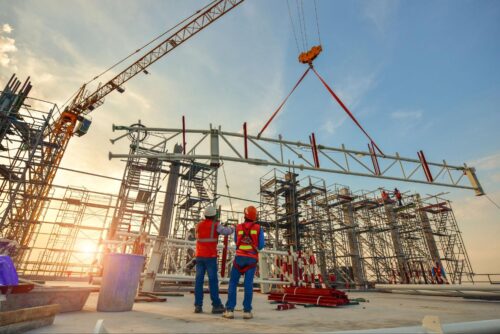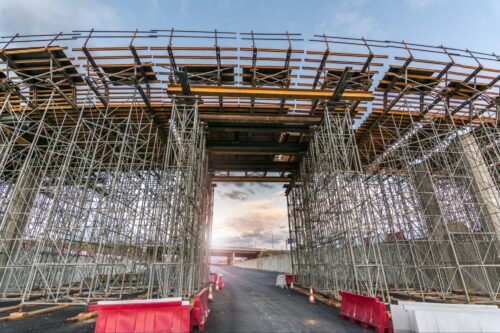Infrastructure Development: It sounds like a daunting and confusing term but really just refers to the development of critical structures to our way of life, such as transportation. Scaffolding has always been a critical component, particularly in bridge construction.
As the demand for more efficient and sustainable construction methods increases, technology is stepping in to transform the way we build bridges. This transformation impacts everything from design and engineering to the very scaffolding systems that support these massive structures.
In this article, we’ll explore the future of scaffolding in infrastructure, particularly in bridge constructions, delve into the latest advancements in scaffolding technology, and discuss how companies like us at Southern Scaffolding are shaping the industry with our expertise in projects such as the Tunbridge Wells Railway station.
So, let’s get stuck to discovering the role of scaffolding in the rapidly evolving world of bridge construction.
Understanding Scaffolding in Construction
To appreciate the impact of technology on bridge construction, we need to understand what scaffolding is and its importance in the construction process. For many of you reading this blog, this won’t be relevant so feel free to skip to section 3.
Scaffolding, in its simplest form, is a temporary structure used to support workers and materials during the construction, maintenance, or repair of buildings and other structures. In the context of bridge construction, scaffolding provides essential access to various sections of the bridge, ensuring safety and efficiency for workers.

There are several types of scaffolding, each with its benefits and applications. Some common types include supported scaffolding, suspended scaffolding, and rolling scaffolding. Supported scaffolding is the most widely used, consisting of a system of platforms and frames anchored to the ground, providing a stable work surface. Suspended scaffolding, on the other hand, hangs from an overhead structure, allowing workers to access hard-to-reach areas. Rolling scaffolding, as the name suggests, is mounted on casters, providing mobility for workers and materials.
The importance of scaffolding in construction cannot be overstated. It ensures worker safety, increases productivity, and allows for the efficient execution of complex tasks. With advancements in technology, scaffolding systems have evolved to become more robust and versatile, allowing construction professionals to take on increasingly challenging infrastructure projects.
The Impact of Technology on Bridge Construction
Technology has had a massive impact on bridge construction, revolutionizing the way we approach the design, engineering, and construction of these vital structures. From computer-aided design (CAD) software to drones for aerial inspections, the industry is embracing innovative solutions to enhance efficiency and safety.
This technological evolution has a direct influence on the scaffolding industry, driving improvements in scaffolding practices for bridge construction. For instance, Building Information Modelling (BIM) software has made it possible to create highly detailed 3D models of scaffolding systems, streamlining the design process, and reducing the risk of errors. Digital tools for planning and design also allow scaffolding companies to optimize material usage and reduce waste, contributing to a more sustainable construction process.
Another example of technology’s impact on bridge construction is the use of advanced materials for scaffolding. Lightweight, high-strength materials such as aluminum and carbon fiber composites have made scaffolding systems more resilient and easier to assemble, ensuring a safer and more efficient work environment.
In addition, automation is making its way into the scaffolding industry, with the development of robotic systems that can assemble and disassemble scaffolding more quickly and accurately than human workers. This not only reduces labor costs but also minimizes the risk of accidents and injuries on the construction site.
These technological advancements highlight the growing synergy between bridge construction and the scaffolding industry, paving the way for a more efficient and sustainable future in infrastructure development.
Advancements in Scaffolding Technology
As technology continues to advance, so does the scaffolding industry, with new innovations poised to redefine how we approach to bridge construction and infrastructure projects. Let’s take a closer look at some of the latest advancements in scaffolding technology:
- Lightweight materials: The use of lightweight, high-strength materials such as aluminum and carbon fiber composites has been a game-changer for the scaffolding industry. These materials enable the creation of scaffolding systems that are not only easier to transport and assemble but also offer improved durability and resistance to the elements.
- Automation and robotics: The introduction of automated systems and robotics in scaffolding assembly and disassembly has the potential to significantly reduce labor costs, increase efficiency, and minimize the risk of accidents on construction sites. These systems are designed to perform tasks with precision and speed, ensuring a safer and more efficient working environment.
- Digital tools for planning and design: The use of digital tools such as BIM software and CAD applications has revolutionized the way scaffolding systems are planned and designed. These tools enable scaffolding professionals to create highly detailed 3D models, optimize material usage, and identify potential issues before they become costly problems on-site.
- Virtual reality (VR) and augmented reality (AR) training: These immersive technologies are being used to provide scaffolding professionals with realistic, hands-on training experiences in a safe and controlled environment. VR and AR can help workers familiarise themselves with complex scaffolding systems, learn how to navigate challenging workspaces and practice vital safety procedures.
These advancements in scaffolding technology offer numerous benefits for bridge construction and infrastructure projects, including increased safety, reduced labor costs, enhanced efficiency, and improved sustainability. As we look to the future, it’s clear that embracing these innovations will be essential for the continued growth and success of the scaffolding industry.
The Future of Bridge Construction and Scaffolding
The future of bridge construction is linked to the evolution of scaffolding technology and practices. As we move forward, the role of scaffolding in infrastructure development will become even more critical, with the industry adapting to accommodate the latest trends and innovations.

One such trend is the increasing emphasis on sustainability in construction. Scaffolding companies are now exploring ways to reduce their environmental impact using eco-friendly materials, waste reduction strategies, and energy-efficient solutions. This shift towards sustainable practices will likely become a standard in the industry, as both public and private entities demand greener construction methods.
Another trend shaping the future of bridge construction is the adoption of modular and prefabricated scaffolding systems. These systems offer increased flexibility, allowing for rapid assembly and disassembly, and can be easily adapted to suit various project requirements. The use of modular scaffolding systems not only saves time and resources but also improves safety by reducing the need for on-site modifications.
The growing popularity of smart construction technologies is another factor that will influence the scaffolding industry. The integration of Internet of Things (IoT) devices and sensors into scaffolding systems can help monitor various aspects of the construction process, such as worker safety, structural integrity, and environmental conditions. This real-time data can be used to improve overall site safety and efficiency, paving the way for a more connected and data-driven approach to bridge construction.
The future of bridge construction will be shaped by ongoing advancements in technology, the adoption of sustainable practices, and the continuous pursuit of innovation. By staying ahead of these trends, scaffolding companies like Southern Scaffolding will continue to play a vital role in the successful completion of major infrastructure projects.
Sustainable Scaffolding Practices
As the construction industry moves towards a more sustainable future, it’s essential for scaffolding companies to adopt eco-friendly practices that support this shift. Sustainable scaffolding practices not only help reduce the environmental impact of construction projects but also contribute to the long-term success and viability of the industry.
One way scaffolding companies can prioritize sustainability is by using materials with a lower environmental footprint, such as recyclable aluminum or timber from responsibly managed forests. In addition, efficient material management, including accurate planning and design, can minimize waste and resource consumption.
Another important aspect of sustainable scaffolding is the use of energy-efficient solutions, such as LED lighting systems and solar-powered equipment, to reduce energy consumption on construction sites. This not only lowers greenhouse gas emissions but can also result in significant cost savings for contractors and clients.
Companies like Southern Scaffolding are leading the way in adopting sustainable practices, offering affordable and reliable scaffolding solutions for bridge construction and infrastructure projects. By partnering with professional scaffolding contractors and equipment suppliers that prioritize sustainability, clients can ensure that their projects are not only structurally sound but also environmentally responsible.
It’s clear that embracing sustainable scaffolding practices is essential for the long-term success of the construction industry and the future of our planet.
Conclusion
In conclusion, the future of bridge construction is shaped by rapid advancements in technology, sustainable practices, and innovative solutions. By embracing these changes, companies like Southern Scaffolding continue to play a vital part in the successful completion of infrastructure projects. As we look forward to a more sustainable and efficient future in bridge construction, it’s essential to choose professional scaffolding contractors who prioritize safety, innovation, and sustainability.
To learn more about Southern Scaffolding’s services and solutions for your next commercial scaffolding project, get in touch with our team today.